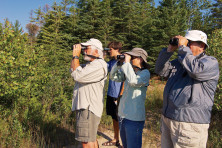Birdwatching Extravaganza
- Share
- Tweet
- Pin
- Share
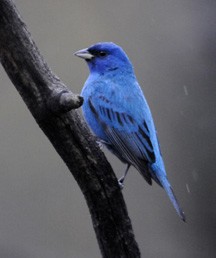
An adult male Indigo Bunting. Photo by Roy Lukes.
Who would think that on this rainy, windy, 44 degree day in the middle of May there were two birds in every bush (as the old saying goes) and a multitude of birds of various descriptions practically waiting in line for food at the feeders. Having flown such long distances to get here, these birds are in great need to restore all that expended energy. Undoubtedly this also accounts for their fairly peacefully putting up with one another in such close quarters.
White-throated and Chipping Sparrows, Baltimore and Orchard Orioles, Rose-breasted Grosbeaks, Cardinals, Indigo Buntings, American Goldfinches, Pine Siskins, White-breasted Nuthatches, Black-capped Chickadees, Mourning Doves, Pileated, Red-bellied, Hairy and Downy Woodpeckers, Nashville, Chestnut-sided, Magnolia, and Blue-winged Warblers, and the bossy Blue Jays, were all in need of food on this blustery day.
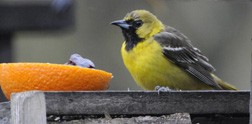
This is a first-spring male Orchard Oriole starting his second year. Photo by Roy Lukes.
As much as we would like to have been at one of several of Northern Door’s May birding hotspots, where some of our friends observed as many as 19 species of warblers within a few hours May 13, being warm and dry indoors while watching and photographing the birds from the comforts of our home proved to be quite satisfactory. Actually we were enjoying a regular bird watching extravaganza such as we’ve seldom experienced over the 28 years we’ve lived here in the woods. The most active species appeared to be the Rose-breasted Grosbeaks, Indigo Buntings, Baltimore Orioles, Red-bellied Woodpeckers, Goldfinches, Purple Finches, House Finches, Pine Siskins and Chipping Sparrows. This is the latest we’ve ever had Siskins at our place, 25 today. Ordinarily they’ve left for their northern breeding grounds by around the middle of April. The most unusual bird today was the Orchard Oriole, a first spring male. Fortunately I was able to get good pictures of this classy bird. There have been a few other reports of them in the county this spring, and they have been known to nest sparingly in past years in this region.
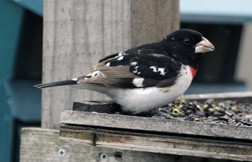
A second-year male Rose-breasted Grosbeak; notice his brown wing feathers. Photo by Roy Lukes.
What’s exciting about having so many birds in your yard is that one can easily separate the adult males and females from the young of last year, some of which can be quite nicely distinguished from the older birds. The Baltimore Orioles and Rose-breasted Grosbeaks are fascinating species to closely observe as you attempt to separate younger second-year birds from the older adults.
Now that there are so many Rose-breasted Grosbeaks here, notice the wing and tail color of the males. Those having brown wings or tails, or both, are second-year birds that were hatched last summer. The brown feathers will be molted during their annual complete molt beginning in later summer, and the wings and tails will then be black.
Now is a good time to consult several excellent bird field guides, such as those written by Sibley, Kaufman, and the National Geographic Birds of North America for accurate descriptions of the various age groups of birds.
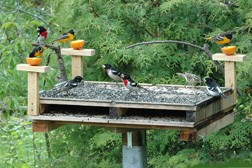
Rose-breasted Grosbeaks, both males and females, and Baltimore Orioles, all males, decorate the Lukes’ platform feeder.
The birds I’ve mentioned thus far do not include several that have already arrived to our woods and hopefully will remain here to nest this summer. Included are the Hermit Thrushes, which have nested here successfully for the past few years and which invariably show up in our front yard to bathe at around 8 pm. We hear them singing from the woods to the north of our house. Another species, the Great Crested Flycatchers whose loud far-reaching vocalizations were silenced today by the cold wet weather, have been here for the past several days. A Red-headed Woodpecker showed up May 15. They nested in our woods the past two summers.
Door County, with its wide variety of bird habitat including open fields and roadsides, upland woods, swamps, bogs, marshes and shores, is an incredibly outstanding region for experiencing bird watching extravaganzas such as Charlotte and I enjoyed from the confines of our home today. We hope you were privileged to do so as well!

